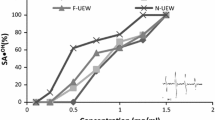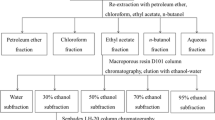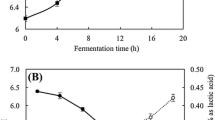Abstract
Antioxidative and cytotoxic effects of chamomile (Matricaria chamomilla) fermented by Lactobacillus plantarum were investigated to improve their biofunctional activities. Total polyphenol (TP) content was measured by the Folin-Denis method, and the antioxidant activities were assessed by the 1,1-diphenyl-2-picrylhydrazyl (DPPH) method and β-carotene bleaching method. AGS, HeLa, LoVo, MCF-7, and MRC-5 (normal) cells were used to examine the cytotoxic effects by 3-(4,5-dimethylthiazol-2-yl)-2,5-diphenyltetrazolium (MTT) assay. The TP content of fermented chamomile reduced from 21.75 to 18.76 mg gallic acid equivalent (mg GAE)/g, but the DPPH radical capturing activity of fermented chamomile was found to be 11.1% higher than that of nonfermented chamomile after 72 h of fermentation. Following the β-carotene bleaching, the antioxidative effect decreased because of a reduction in pH during fermentation. Additionally, chamomile fermented for 72 h showed a cytotoxic effect of about 95% against cancer cells at 12.7 mg solid/ml of broth, but MRC-5 cells were significantly less sensitive against fermented chamomile samples. These results suggest that the fermentation of chamomile could be applied to develop natural antioxidative and anticancer products.
摘要
目的
研究洋甘菊(Matricaria chamomilla) 经 Lactobacillus plantarum 乳杆菌发酵,可以改善其抗氧化和细胞 毒性。
方法
通过Folin-Denis 方法测量酚类物质的总含量 (TP);通过二苯代苦味酰肼(DPPH)法和β- 胡萝卜素漂白法评价抗氧化活性;通过MTT 法 测定AGS、HeLa、LoVo、MCF-7 和MRC-5(正 常)细胞的细胞毒性作用。
结论
发酵后洋甘菊的TP 含量从21.75 mg GAE/g 降至 18.76 mg GAE/g(GAE:子酸当量),但是DPPH 自由基清除率在发酵72 h 后比未发酵的高 11.1%。由于发酵期间pH 的降低,在β-胡萝卜素 漂白之后,其抗氧化效果降低。此外,发酵72 h 后的洋甘菊对癌细胞有约95%的细胞毒性作用, 但是MRC-5 细胞的作用不敏感。这些结果表明, 洋甘菊的发酵可用于开发天然抗氧化和抗癌产 品。
Similar content being viewed by others
References
Batista, A.L.A., Diógenes Alves UchÔa Lins, R., de Souza Coelho, R., et al., 2014. Clinical efficacy analysis of the mouth rinsing with pomegranate and chamomile plant extracts in the gingival bleeding reduction. Complement. Ther. Clin. Pract., 20(1):93–98. http://dx.doi.org/10.1016/j.ctcp.2013.08.002
Benzie, I.F.F., Strain, J.J., 1996. The ferric reducing ability of plasma (FRAP) as a measure of “antioxidant power”: the FRAP assay. Anal. Biochem., 239(1):70–76. http://dx.doi.org/10.1006/abio.1996.0292
Bianco, M.I., Lúquez, C., de Jong, L.I.T., et al., 2008. Presence of Clostridium botulinum spores in Matricaria chamomilla (chamomile) and its relationship with infant botulism. Int. J. Food Microbiol., 121(3):3357–3360. http://dx.doi.org/10.1016/j.ijfoodmicro.2007.11.008
Chang, H., Mi, M., Ling, W., et al., 2008. Structurally related cytotoxic effects of flavonoids on human cancer cells in vitro. Arch. Pharm. Res., 31(9):1137–1144. http://dx.doi.org/10.1007/s12272-001-1280-8
Choi, S.S., Kim, Y., Han, K.S., et al., 2006. Effects of Lactobacillus strains on cancer cell proliferation and oxidative stress in vitro. Lett. Appl. Microbiol., 42(5):452–458. http://dx.doi.org/10.1111/j.1472-765X.2006.01913.x
Cvetanovic, A., Švarc-Gajic, J., Maškovic, P., et al., 2015a. Antioxidant and biological activity of chamomile extracts obtained by different techniques: perspective of using superheated water for isolation of biologically active compounds. Ind. Crop. Prod., 65:582–591. http://dx.doi.org/10.1016/j.indcrop.2014.09.044
Cvetanovic, A., Švarc-Gajic, J., Zekovic, Z., et al., 2015b. Comparative analysis of antioxidant, antimicrobiological and cytotoxic activities of native and fermented chamomile ligulate flower extracts. Planta, 242(3):721–732. http://dx.doi.org/10.1007/s00425-015-2308-2
Dong, J., Zhao, L., Cai, L., et al., 2014. Antioxidant activities and phenolics of fermented Bletilla formosana with eight plant pathogen fungi. J. Biosci. Bioeng., 118(4):396–399. http://dx.doi.org/10.1016/j.jbiosc.2014.03.003
Dueñas, M., Fernandez, D., Hernandez, T., et al., 2005. Bioactive phenolic compounds of cowpeas (Vigna sinensis L.). Modifications by fermentation with natural microflora and with Lactobacillus plantarum ATCC 14917. J. Sci. Food Agric., 85(2):297–304. http://dx.doi.org/10.1002/jsfa.1924
Durackova, Z., 2010. Some current insights into oxidative stress. Physiol. Res., 59:459–469.
Farideh, Z.Z., Bagher, M., Ashraf, A., et al., 2010. Effects of chamomile extract on biochemical and clinical parameters in a rat model of polycystic ovary syndrome. J. Reprod. Infertil., 11(3):169–174.
Guzelmeric, E., Vovk, I., Yesilada, E., 2014. Development and validation of an HPTLC method for apigenin 7-Oglucoside in chamomile flowers and its application for fingerprint discrimination of chamomile-like materials. J. Pharm. Biomed. Anal., 107(25):108–118. http://dx.doi.org/10.1016/j.jpba.2014.12.021
Hur, S.J., Lee, S.Y., Kim, Y.C., et al., 2014. Effect of fermentation on the antioxidant activity in plant-based foods. Food Chem., 160(1):346–356. http://dx.doi.org/10.1016/j.foodchem.2014.03.112
Ibrahim, N.A., Mustafa, S., Ismail, A., 2014. Effect of lactic fermentation on the antioxidant capacity of Malaysian herbal teas. Int. Food Res. J., 21(4):1483–1488.
Jo, M.N., Jung, J.E., Lee, J.H., et al., 2014. Cytotoxicity of the white ginseng extract and red ginseng extract treated with partially purified ß-glucosidase from Aspergillus usamii KCTC 6954. Food Sci. Biotechnol., 23(1):215–219. http://dx.doi.org/10.1007/s10068-014-0029-0
Koch, C., Reichling, J., Kehm, R., et al., 2008. Efficacy of anise oil, dwarf-pine oil and chamomile oil against thymidine-kinase-positive and thymidine-kinase-negative herpesviruses. J. Pharm. Pharmacol., 60(11):1545–1550. http://dx.doi.org/10.1211/jpp.60.11.0017
Kotnik, P., Skerget, M., Knez, Z., 2007. Supercritical fluid extraction of chamomile flower heads: comparison with conventional extraction, kinetics and scale-up. J. Supercrit. Fluids, 43(2):192–198. http://dx.doi.org/10.1016/j.supflu.2007.02.005
Lee, J.Y., Hwang, W.I., Lim, S.T., 2004. Antioxidant and anticancer activities of organic extracts from Platycodon grandiflorum A. De Candolle roots. J. Ethnopharmacol., 93(2-3):409–415. http://dx.doi.org/10.1016/j.jep.2004.04.017
Li, B., Wang, C.Z., He, T.C., et al., 2010. Antioxidants potentiate American ginseng-induced killing of colorectal cancer cells. Cancer Lett., 289(1):62–70. http://dx.doi.org/10.1016/j.canlet.2009.08.002
Lim, Y., Jeong, T., Tyner, A.L., et al., 2007. Induction of cell cycle arrest and apoptosis in HT-29 human colon cancer cells by dietary compounds luteolin. Am. J. Physiol. Gastrointest. Liver Physiol., 292(1):66–75. http://dx.doi.org/10.1152/ajpgi.00248.2006
Michlmayr, H., Brandes, W., Eder, R., et al., 2011. Characterization of two distinct glycosyl hydrolase family 78 a-L-rhamnosidases from Pediococcus acidilactici. J. Appl. Environ. Microbiol., 77(18):6524–6530. http://dx.doi.org/10.1128/AEM.05317-11
McKay, D.L., Blumberg, J.B., 2006. A review of the bioactivity and potential health benefits of chamomile tea (Matricaria recutita L.). Phytother. Res., 20(8):619–633. http://dx.doi.org/10.1002/ptr.1936
Moreno, M.I.N., Isla, M.I., Sampietro, A.R., et al., 2000. Comparison of the free radical-scavenging activity of propolis from several regions of Argentina. J. Ethnopharmacol., 71(1-2):109–114. http://dx.doi.org/10.1016/S0378-8741(99)00189-0
Ooi, K.L., Loh, S.I., Tan, M.L., et al., 2015. Growth inhibition of human liver carcinoma HepG2 cells and a-glucosidase inhibitory activity of Murdannia bracteata (C.B. Clarke) Kuntze ex J.K. Morton extracts. J. Ethnopharmacol., 162(13):55–60. http://dx.doi.org/10.1016/j.jep.2014.12.030
Othman, A., Ismail, A., Ghani, N.A., et al., 2007. Antioxidant capacity and phenolic content of cocoa beans. Food Chem., 100(4):1523–1530. http://dx.doi.org/10.1016/j.foodchem.2005.12.021
Petroianu, G., Szoke, E., Kalasz, H., et al., 2009. Monitoring by HPLC of chamomile flavonoids exposed to rat liver microsomal metabolism. Open J. Med. Chem., 3:1–7. http://dx.doi.org/10.2174/1874104500903010001
Poyton, R.O., Ball, K.A., Castello, P.R., 2009. Mitochondrial generation of free radicals and hypoxic signaling. Trends Endocrinol. Metab., 20(7):332–340. http://dx.doi.org/10.1016/j.tem.2009.04.001
Pulido, R., Bravo, L., Saura-Calixto, F., 2000. Antioxidant activity of dietary polyphenols as determined by a modified ferric reducing/antioxidant power assay. J. Agric. Food Chem., 48(8):3396–3402. http://dx.doi.org/10.1021/jf9913458
Reuter, S., Gupta, S.C., Chaturvedi, M.M., et al., 2010. Oxidative stress, inflammation, and cancer: how are they linked? Free Radic. Biol. Med., 49(11):1603–1616. http://dx.doi.org/10.1016/j.freeradbiomed.2010.09.006
Santos, M.M., Piccirillo, C., Castro, P.M., et al., 2012. Bioconversion of oleuropein to hydroxytyrosol by lactic acid bacteria. World J. Microbiol. Biotechnol., 28(6):2435–2440. http://dx.doi.org/10.1007/s11274-012-1036-z
Schraufstätter, I., Hyslop, P.A., Jackson, J.H., et al., 1988. Oxidant-induced DNA damage of target cells. J. Clin. Investig. (Lond.), 82(3):1040–1050. http://dx.doi.org/10.1172/JCI113660
Sebai, H., Jabri, M.A., Souli, A., et al., 2014. Antidiarrheal and antioxidant activities of chamomile (Matricaria recutita L.) decoction extract in rats. J. Ethnopharmacol., 152(2): 327–332. http://dx.doi.org/10.1016/j.jep.2014.01.015
Sun, S.Y., Hail, N.Jr., Lotan, R., 2004. Apoptosis as a novel target for cancer chemoprevention. J. Nat. Cancer Inst., 96(9):662–672. http://dx.doi.org/10.1093/jnci/djh123
Tadbir, A.A., Pourshahidi, S., Ebrahimi, H., et al., 2015. The effect of Matricaria chamomilla (chamomile) extract in Orabase on minor aphthous stomatitis, a randomized clinical trial. J. Herb. Med., 5(2):71–76. http://dx.doi.org/10.1016/j.hermed.2015.05.001
Torino, M.I., Limon, R.I., Martinez-Villaluenga, C., et al., 2013. Antioxidant and antihypertensive properties of liquid and solid state fermented lentils. Food Chem., 136(2):1030–1037. http://dx.doi.org/10.1016/j.foodchem.2012.09.015
Vijayababu, M.R., Kanagaraj, P., Arunkumar, A., et al., 2006. Quercetin induces p53-independent apoptosis in human prostate cancer cells by modulating Bcl-2-related proteins: a possible mediation by IGFBP-3. Oncol. Res., 16(2):67–74.
Wang, X., Wei, Y., Yuan, S., et al., 2006. Potential anticancer activity of litchi fruit pericarp extract against hepatocellular carcinoma in vitro and in vivo. Cancer Lett., 239(1): 144–150. http://dx.doi.org/10.1016/j.canlet.2005.08.011
Wang, Y., Tang, H., Holmes, E., 2004. Metabolomic strategy for the classification and quality control of phytomedicine: a case study of chamomile flower (Matricaria recutita L.). Planta Med., 70(3):250–255. http://dx.doi.org/10.1055/s-2004-815543
Yang, J., Ji, Y., Park, H., et al., 2014. Selection of functional lactic acid bacteria as starter cultures for the fermentation of Korean leek (Allium tuberosum Rottler ex Sprengel). Int. J. Food Microbiol., 191(17):164–171. http://dx.doi.org/10.1016/j.ijfoodmicro.2014.09.016
Yoon, H.J., Lee, K.A., Lee, J.H., et al., 2015. Effect of fermentation by Bacillus subtilis on antioxidant and cytotoxic activities of black rice bran. Int. J. Food Sci. Technol., 50(3):612–618. http://dx.doi.org/10.1111/ijfs.12693
Zhang, Z., Lv, G., Pan, H., et al., 2012. Production of powerful antioxidant supplements via solid-state fermentatin of wheat (Triticum aestivum Linn.) by Cordyceps militaris. Food Technol. Biotechnol., 50(1):32–39.
Author information
Authors and Affiliations
Corresponding author
Additional information
Project supported by the Ministry of Agriculture, Food and Rural Affairs (No. 314073-03), the Ministry for Food, Agriculture, Forestry and Fisheries, Korea (No. 614102-2), and the National Research Foundation of Korea (No. 2009-0093824)
ORCID: Hyun-Dong PAIK, http://orcid.org/0000-0001-9891-7703
Rights and permissions
About this article
Cite this article
Park, EH., Bae, WY., Eom, SJ. et al. Improved antioxidative and cytotoxic activities of chamomile (Matricaria chamomilla) florets fermented by Lactobacillus plantarum KCCM 11613P. J. Zhejiang Univ. Sci. B 18, 152–160 (2017). https://doi.org/10.1631/jzus.B1600063
Received:
Revised:
Published:
Issue Date:
DOI: https://doi.org/10.1631/jzus.B1600063




